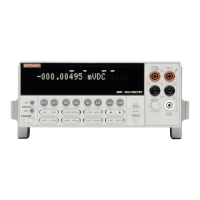Troubleshooting
2-27
Test 105.8 – Group Execute Trigger (GET)
Pass/Fail
GET signal not detected.
Trigger 8 (STI8) is set up as an input and the 9914 (U622) is then programmed to gen-
erate a GET signal.
U618 and U622.
Test 105.11 through 105.18 – Trigger shorts
Pass/Fail
Short detected between system triggers.
In test 105.11, STI1 is programmed as the trigger input. Each of the other triggers (STI2
through STI7 and GET) are programmed to toggle in sequence. If a trigger is detected
at STI1, a short is indicated and the test fails. The test is repeated for STI2 through STI8
in tests 105.12 through 105.18.
Ordinarily, Built-In-Tests should be run with no external connections. However, the
Trigger Shorts tests may be used to verify proper operation at the external trigger bus
connector (J1029, J1030). For example, by shorting pins 1 and 2, tests 105.11 and 105.12
should fail indicating that the short was detected between system trigger 1 and system
trigger 2.
A/D converter and analog circuitry tests
There are three data words used to conÞgure and control the instrument. The DC STB
data word is used to control A/D multiplexing and the input gain conÞguration. The
R1 STB data word is used to control the DCV and ohms conÞguration. The R2 STB data
word is used to control the ACV conÞguration. Each 32-bit data word is generated in
the digital section and is passed by U808 to the three sets of control shift registers. U808
uses the two least signiÞcant bits of a data word to determine which strobe (DC_STB,
R1_STB or R2_STB) will be active to latch the data word into the appropriate shift reg-
isters.
Tables 2-5 through 2-7 lists the control registers for the three strobes and provides a
functional description of each bit. The documentation for each of the following Built-
In Tests includes the logic states for the registers after each test is manually run. Also
included as a troubleshooting aid is Table 2-8 which provides the state of the control
lines for each selected input of multiplexer U511.

